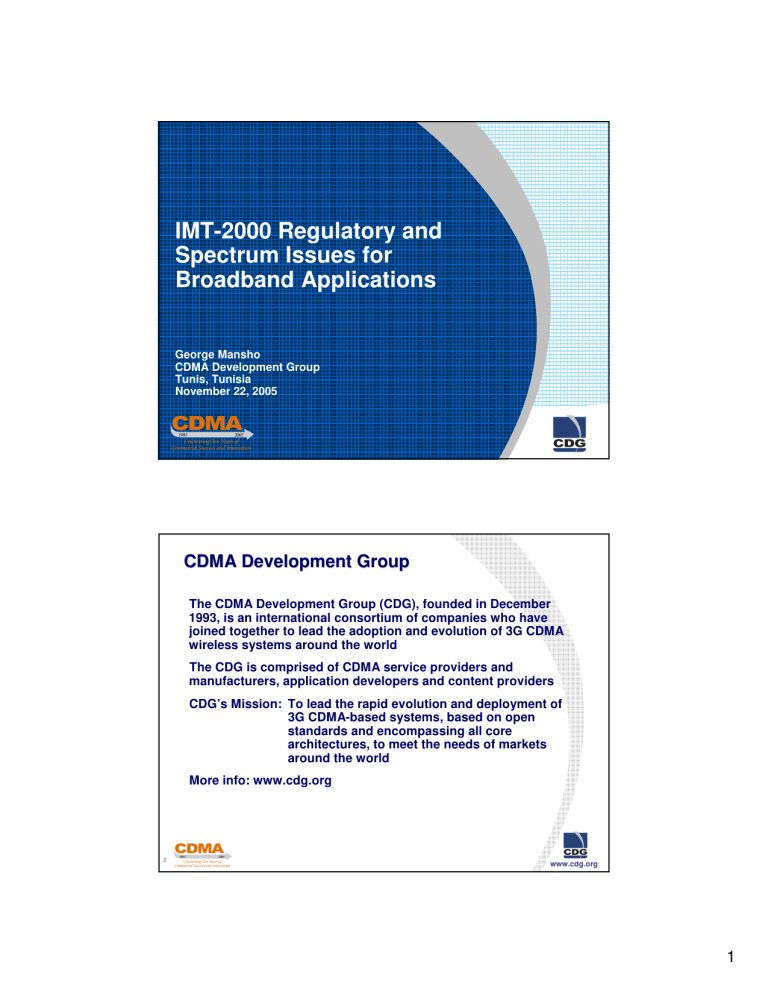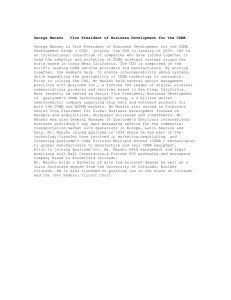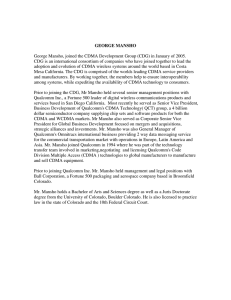IMT-2000 Regulatory and Spectrum Issues for Broadband Applications CDMA Development Group
advertisement

IMT-2000 Regulatory and Spectrum Issues for Broadband Applications George Mansho CDMA Development Group Tunis, Tunisia November 22, 2005 CDMA Development Group The CDMA Development Group (CDG), founded in December 1993, is an international consortium of companies who have joined together to lead the adoption and evolution of 3G CDMA wireless systems around the world The CDG is comprised of CDMA service providers and manufacturers, application developers and content providers CDG’s Mission: To lead the rapid evolution and deployment of 3G CDMA-based systems, based on open standards and encompassing all core architectures, to meet the needs of markets around the world More info: www.cdg.org 2 www.cdg.org 1 CDMA2000 is the Leading 3G Technology • 129 operators in 60 countries on six continents, including developing countries • 200 million or 10% of all wireless subscribers use CDMA2000® today • There will be nearly 500 million CDMA2000 subscribers serving 20% of total users in 2009* 200 Million CDMA2000 35 Million WCDMA September 2005 3G worldwide subscribers Millions 200 150 100 50 3 20 04 CDMA2000 WCDMA 20 05 20 03 20 02 20 01 - *Source: The Yankee Group, June 2005 www.cdg.org CDMA2000 1xEV1xEV-DO: The Leading Broadband Technology • Data optimized delivers 300-800 kbps up to 2.4 Mbps in commercial networks, the fastest speeds of any wireless technology deployed today • Applications: • • DSL replacement • Devices: 150 including handsets, PC cards, fixed terminals • 24 networks deployed, 30 in deployment worldwide 18.5 million, or 9%, CDMA2000 subscribers access CDMA2000 1xEV-DO technologies today; over 250 million by 2009* • 4 • Advanced mobile data applications such as video and audio downloads and TV broadcasts Mobile broadband *Source: The Yankee Group, June 2005 www.cdg.org 2 CDMA2000 Evolution Path to Broadband and All IP CDMA2000 has at least 2 years’ lead time over other technologies • CDMA2000 1xEV-DO Rel 0: Broadband commercial since 2002 • CDMA2000 1xEV-DO Rev A: Multimedia on all-IP deployed in 2006 − SKT, KFT, KDDI, Verizon and Sprint have already announced their deployments • CDMA2000 1xEV-DO Rev B: Up to 73.5 Mbps available in 2008 Up to 20 MHz Data + IP Voice Scalable Bandwidth EVEV-DO CDMA2000 1xEV1xEV-DO 1.25 MHz Data + IP Voice ISIS-856 Release 0 Dedicated for packet data 2.4 Mbps peak (fwd link) 2002 Revision A 3.1 Mbps fwd link 1.8 Mbps rev link, lower latency, VoIP Up to 15 carriers 73.5 Mbps fwd link 27 Mbps rev link 2008/2009 2006 5 www.cdg.org The Value of Improving Connectivity It’ It’s not just about voice …. It’ It’s about voice and data $100,000 $100,000 y = 48948x + 103.27 2 R = 0.7387 y = 23995x R2 = 0.6681 $1,000 $100 0.0% $10,000 GDP per capita, 2002 GDP per capita, 2002 $10,000 20.0% 40.0% 60.0% 80.0% 100.0% 120.0% $1,000 0.0% 0.1% 1.0% $100 100.0% 10.0% Telephony penetration, 2002 Internet penetration, 2002 For each 1% increase in Mobile penetration, GDP per capita goes up by US$240 For each 1% increase in Internet penetration, GDP per capita goes up by US$593 Although mobile voice communications are bridging the digital divide, divide, regulatory and spectrum policy should continue to encourage the penetration of mobile broadband data connectivity 6 Source: Michael Minges, TMG Telcom, and ITU World Telecommunications Database Statistics, 2003. www.cdg.org 3 3G CDMA – Satisfying the Demand for Wireless Voice and Broadband Data Today! • Toll-quality Voice communications (equal or better than landline) • Commercial-grade infrastructure (switching, billing, authentication, etc.) • Broadband Data transmissions (multiples greater than ISDN speeds) • Thousands of applications (multimedia, multicasting, messaging, etc.) • Secure transmissions (including DRM, antispam, fraud control, etc.) • Low cost per minute, megabyte or message (due to spectral efficiency) • Excellent coverage (with in-building, multimode & robust hand-off services) • More than 200 million paying subscribers worldwide and growing (~4M/mo)! • Commercially available devices (more than 735 devices from 50 vendors) − Small and attractive form factors − DataData-enabled devices based on IEEE (TCP/IP) standards − WWAN connectivity embedded into laptops − Operating systems based on “open” open” execution environment standards − Low battery power consumption 7 www.cdg.org 3G CDMA for the Middle East and Africa A large opportunity exists to increase voice & broadband penetrations penetrations Majority of voice telephony will continue to be serviced by 2G GSM 3G CDMA will serve voice telephony and other key market segments: Low Cost Voice Telephony: − Spectral efficiency and capacity of 3G CDMA networks supports lower voice tariffs − Spectral efficiency leads to reduced costs per subscriber (Notable example: India) − Satisfies Universal Service Obligations for “under-serviced” areas and rural deployments Broadband Data: − High-speed, secure and cost-effective Internet connectivity − Available wherever wide area coverage exists: urban, suburban, rural and in-buildings Multimedia Services: − 3G CDMA networks support multicasting, multimedia streaming and on demand services Challenges for 3G CDMA in the Middle East and Africa: Availability of the appropriate spectrum allocations (450, 800, 1900 & 2100 MHz) Ultra low-cost voice-centric handsets 8 www.cdg.org 4 3G CDMA Broadband Connectivity CDMA2000 EVEV-DO is delivering the highest broadband rates 5100 4.9 Mbps 4800 73.5 Mbps** while mobile 4500 4200 Peak Data Rate (kbps)* 3900 3600 3300 3.1 Mbps 3000 2700 2.4 Mbps 2400 2100 1800 1500 1200 900 600 300 0 307 kbps 14.4 kbps 64 kbps ISIS-95B ISIS-95A 1xEV1xEV-DO Rev. A 1xEV1xEV-DO Rel. Rel. 0 1X EVEV-DO Rev. B * Forward link in a mobile environment using 1.25 MHz of spectrum ** Using 20 MHz of spectrum 9 www.cdg.org 3G CDMA Enables Lowers Tariffs CDMA2000 1X and EVEV-DO enables the lowest cost per bit & Erlang Combined Voice & Data Network Expense Network Expense/User/Month (500 Minutes of Use) USD $25.00 $22.50 GSM/GPRS EDGE WCDMA $20.00 $17.50 1X 1X / EV-DO Rel. 0 The Lower the better! $15.00 $12.50 $10.00 $7.50 $5.00 $2.50 $0.00 10 20 30 40 50 60 70 80 90 100 Megabytes per User Operators Prefer Network Technologies that are Affordable & Evolutionary Evolutionary 10 Source: The Economics of Wireless Data, http://www.qualcomm.com/main/whitepapers/WirelessMobileData.pdf Assumptions: On demand Traffic: a) 15% of traffic demand occurs at the busy hour, b) 7,600 kbps / sq km at busy hour, c) 5MHz Multicast Traffic: a) 2,000 subscribers / cell, b) 30 live streaming minutes / day at 128kbps data rate, c) 1.25MHz www.cdg.org 5 3G CDMA Capacity Advantage Mobile Operators are able to profit from lower tariffs Greater spectral efficiency leads to greater capacity Greater call capacity can lead to lower tariffs for voice service Greater data throughput can lead to reduced data tariffs Mobile Data Mobile Voice India After a free 3-month trial period, an unlimited data plan for cell phones at $10 a month Free incoming calls, $0.008 per minute (outgoing) Lowest Mobile Data Tariff in the world Lowest Mobile Voice Tariff in the world Affordable and evolutionary 3G CDMA networks are driving tariffs lower 11 www.cdg.org Impact of 3G CDMA on India CDMA created a competitive landscape that made wireless affordable affordable Subscribers (Million) 70 Within the 1st year mobile CDMA was introduced (2002) Rp4.00/min. Voice Tariffs Tariffs drop by 42% Teledensity rose by an additional 1.7% 60 30 10 0 2.5 GSM 2.0 Wireless Teledensity 2.8% CDMA (Mobile + Fixed Wireless) Rp1.00/min. Voice Tariffs Wireless Teledensity 0.5% 2001 4.0 3.0 Tariffs ( Rp/min) 20 4.5 3.5 Wireless Teledensity 4.6% 50 40 Wireless Teledensity 6.5% 1.0 Wireless Teledensity 1% 0.5 2002 2003 2004 Q3, 2005 64 14 71 25 79 34 84 44 GSM Networks: 39 CDMA Networks: 5 1.5 Tariffs ( Rp / Min) 80 0.0 Wireless Growth Since Introduction of Mobile CDMA (2002-2005) Tariffs Decrease 75% Teledensity Increase Subscriber Growth (CAGR) 12 6% 205% (CDMA) Sources: CDG, TelecomWatch, AUSPI, COAI and TRAI, October 2005 74% (GSM) www.cdg.org 6 3G is Fulfilling the Demand for Mobile Services Serving a large number of personalized mobile data services 13 www.cdg.org Source: “Broadband Wonderland”, Fortune Magazine, September 20, 2004 3G is Fulfilling Universal Service Obligations Connecting citizens to voice & Internet services In India, Reliance will meet universal service obligations by providing 3G service to 48,310 villages that don’t have public phone facilities1 Rainbow Chalta Firta PCO In India, Shyam Telecom has equipped a fleet of around 200 self-employed rickshaw drivers with a mobile calling office, including fax2 In the Dominican Republic, Tricom deployed over 1,700 public pay phones in underserved rural areas. These phones will eventually be used for high-speed Internet access3 In Brazil, Anatel and Lucent provided universal broadband (800kbps @ 45km) access with 3G In Ecuador, Edumasters installed 3G kiosks at several public schools to provide free Internet access. Panama is next.4 In Chile, BellSouth provided 3G broadband access to 667 schools nationwide5 1. http://www.thehindubusinessline.com/2004/09/20/stories/2004092002090100.htm 2. http://www.hellorainbow.com/aboutus.asp 3. BNAmericas.com, “GEC-Tel, Tricom Partner for wireless Network – Dominican Republic, November 20th, 2004 4. http://projetoscd.isat.com.br 5. www.edumasters.net 6. http://www.subtel.cl/servlet/page?_pageid=57&_dad=portal30&_schema=PORTAL30&p_language=e, Sept. 3, 2003 14 www.cdg.org 7 3G is Fulfilling Public Safety Initiatives Protecting and saving lives In the U.S., 3G carriers offer E911 services with accurate (530m) position location capabilities1 In Japan, SECOM launched a nationwide location-based security service2 In China, Unicom donated 150 kid tracker devices to the Beijing School of the Blind3 In Korea, SK Telecom and the National Police Agency introduced a Missing Children Service4 In Canada, the Ontario Police quickly access vital information (including fingerprint IDs) and respond to emergencies instantly with position location dispatch5 In Florida, the Broward County Sheriff’s Office uses 3G for child protection services5 1. 2. 3. 4. 5. www.fcc.gov/911/enhanced/ www.secom.co.jp www.chinaunicom.com.hk www.cnn.com, Friday October 1st, 2004 CDMA A-List Award Winners 15 www.cdg.org Spectrum Allocations To deploy 3G requires the allocation of the appropriate spectrum Providing affordable coverage is crucial in wireless telecommunications. telecommunications. The warmer (lower) frequencies are best! WCDMA 2.1 GSM 900 CDMA 800 TD-SCDMA 2.1 CDMA 1.7 GSM 1.8 CDMA 450 1GHz 802.15.1 Bluetooth 2.4 CDMA 1.9 802.11 b, g Wi-Fi 2.4 2GHz cdma2000® 450, 800, 1.7, 1.9, 2.1 802.15.3a UWB 3.1-10.6 802.16 LMDS 28-29 802.11 a, e Wi-Fi 5.0 5GHz 11GHz 802.16a, e 802.16a, e WiMAX WiMAX 5.8 2-11 Licensed & Unlicensed 16 Licensed Spectrum vs Unlicensed Spectrum The use of unlicensed spectrum creates interference issues 29GHz Licensed Unlicensed www.cdg.org 8 “When You Come to a Fork in the Road, Take It.” It.” -Yogi Berra, American "Philosopher” "Philosopher” and Sports Celebrity 17 www.cdg.org Road to the Future 3G CDMA – A proven and robust road map to economic development ! " " # $ %& '" ( & ) * &,+ 800 MHz CDMA will dominate well into the 21st Century 1900 MHz 450 MHz 2100 MHz ? 18 www.cdg.org 9 Conclusion Regulatory and spectrum policies should support the option to deploy 3G CDMA The Future is both voice telephony penetration and Internet connectivity The Middle East and Africa need both to accelerate economic growth. The allocation of the “warmer (lower) radio frequencies” provides the best geographic coverage and network economic solution The 800 MHz and 450 MHz frequency allocations are the most valuable to own A “technology neutral” licensing policy follows our industry’s “best practices” When you come to the fork in the technology road, take it. Thank you. 19 www.cdg.org 10


